Yoshiyuki Kobayashi, Naotake Hirao

A method to design a model stirling engine
Yoshiyuki Kobayashi, Naotake Hirao

1. Heat balance
For example, the output of a α-type Stirling engine having swept volume 1cm3 is around 30% of a calculation value by Schmidt theory. Thermal efficiency of the engine does not reach 1%. This is due to various losses which occur within and without the engine. A design to reduce these losses is necessary.
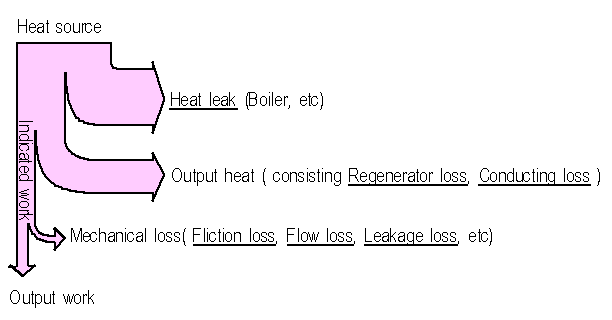
Fig.1 Heat balance of Stirling engine
2. Heater
It is necessary for a heater to have some properties.
1) A large area for heat transfer
2) A minimum dead volume
3) Flow loss of acting gas be small.
4) Heat-resistance
In a practical stirling engine, the heater which arranged many pipes of a narrow path is principally used in order to get an area for heat tranfer. However, for model Stirling engines, a cap type heater is more suitable than a many pipes type heater needing solder brazing. A heat cap type has a weak point that an area for heat transfer is small in comparison with many pipes type, but overall heat transfer to inside gas can be found by doing thickness of a cap thinly.
Ceramics can be used for a heater, but the heat transfer decreases in comparison with metal because the thermal conductivity is small. However, the overall heat transfer may improve if heat-resistant ceramics enable a high temperature of the cap surface.
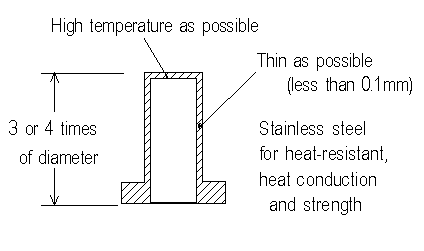
3. Conduction loss and Heat regenarator
When a side wall is thick, a large quantity of heat flows through a wall by heat conduction, and difference of temperature cannot be kept, and the output decreases. Therefore, a side wall had better be thin as possible. If the cap wall is thin, a low temperature side cylinder can be arranged in a near place, and a gas passage can be shortened, and as a result, a dead space can be reduced.
Flow loss is easy to become large by a size effect in a small engine. Therefore most model engines do not have heat regenerator. However, a temperature incline produces it on the side of a heat cap, and acting gas touched inward of the wall slightly functions as heat regenerator.
When ceramics is used for this part, the conduction loss is small even if it is not extremely thin wall thickness. When ceramics is used for this part, the conduction loss is small even if it is not extremely thin wall thickness. In this case when heat regenatator by metal wire is installed as had shown in figure 3, it is effective.
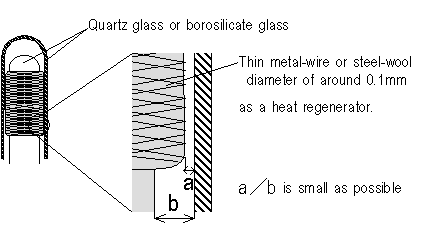
4. Volume arrangement
The big compression ratio is effective in order to get the high output at a limited swept volume. At first, as a method to reduce the dead volume, the volume of a gas passage can be reduced. Therefore the cylinder arrangement that distance with expansion space and compression space is short is advantageous.
If clearance of the cap inside is made small, the death capacity can be reduced. However, as the number of engine turn rises, too small clearance brings big flow resistance, and a rise of piston speed is obstructed.
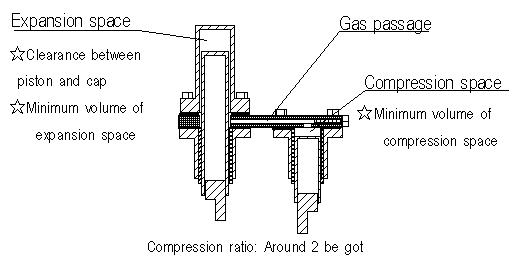
Fig.4 Volume arrangement of a α-type engine
5. Fliction loss
A piston-cylinder must have enough airtightness in no lubrication, and it is necessary for friction loss to be the smallest. Piston rings are usually used in an engine of other kinds. However, the frictional force that a piston ring brings is too big for the small output of a model stirling engine.
It can be formed metal piston-cylinders by fitting. However, in that case, transformation by thermal expansion causes frictional force and a gas leak and the surface damage.
There is a method to divert a glass sylinge to a piston-cylinder as a solution. As for the glass piston-cylinder, the strength can not be expected, but the smallest leak and the smallest friction are maintained. Because a side thrust generates big friction when a glass syringe is used, appropriate drive mechanism should be chosen.
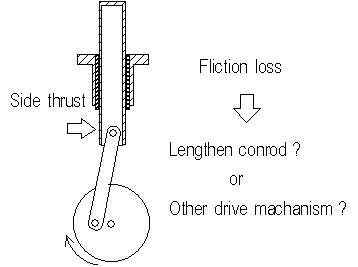
6. Drive mechanism
As for the work that gas does, it is deducted mechanical loss, and left energy is output as axis work. As engine speed increases, machine losses increase. In other words, reduction of a machanical loss boosts engine speed and the output.
Figure 6 shows examples of drive mechanism to minimize the side thrust.

Fig.6 Drive mechanism
As a cause of a mechanical loss except friction loss of a piston, there are
joints and bearings of a mechanical linkage part. These can reduce the degree
friction loss that is to use a ball bearing. A lack of hardness and weight of
moving parts disturb increase of engine speed. Therefore, each part needs as
possible light weight and hardness.
7. Leakage loss
A leak of acting gas decreases the output. When a model stirling engine does not move, at first of all, gass leak should be checked .
When a little leak loss occurs because piston-cylinder is short, the output decreases. However, the thing is hard to be noticed. If a syringe is used, length had better be longer than a diameter at least.